Search results for: 'stone of'
-
 Roman intaglio with hippocampus
Roman intaglio with hippocampusBeautiful depiction of the popular mythical creature from Greek and Roman art. The orange glass paste copies an engraved carnelian gem. From the Roman period.
Price: on request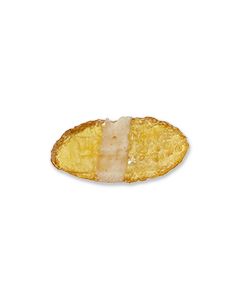 Roman intaglio
Roman intaglioRing insert made from beautiful, bright yellow glass paste. From the Professor Brosch collection of ancient gems.
Price: on request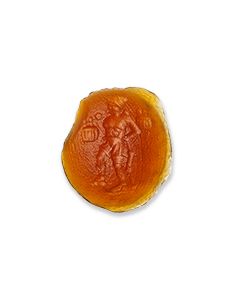 Roman intaglio with Odysseus as a beggar
Roman intaglio with Odysseus as a beggarThe roman intaglio shows an important scene from the Odyssey in which Odysseus returns home after his long journey. The hero is disguised as a beggar. He wears his pilos hat and is resting his weight on a stick.
Price: on request Neolithic axe head from Luetzow in Northern Germany
Neolithic axe head from Luetzow in Northern GermanyPolished axe made of beautiful brown flint. It was found more than 100 years ago near the town of Luetzow.
Price: on request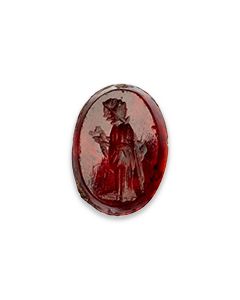 Roman intaglio of carnelian
Roman intaglio of carnelianThe gem stone from the Late Roman Imperial period is engraved in linear style. It shows a standing person in a cloak.
Price: on request Mesopotamian cylinder seal
Mesopotamian cylinder sealMade of beautiful red stone, worked with the drill. From the transitional period between Chalcolithic and Early Bronze Age in Mesopotamia.
Price: on request Egyptian heart scarab
Egyptian heart scarabBig beetle stone from the Late Period of Ancient Egypt. Scarabs of this kind have been placed next to the heart on mummies. Nice mint green fayence.
Price: on request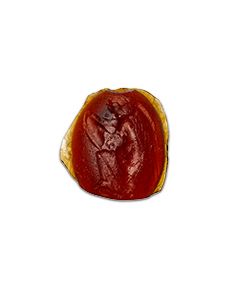 Roman intaglio with goddess of victory
Roman intaglio with goddess of victoryThe glass paste features a famous depiction of Victoria writing the names of victors in battle on a large shield. The motif reiterates a 1st century bronze statue.
Price: on request Dark Roman glass paste with white band
Dark Roman glass paste with white bandThe Roman ring insert is in excellent condition. The small-format motif is not clearly identifiable, but it may show a head.
Price: on request Campanian red figure Hydria with thermoluminescence analysis
Campanian red figure Hydria with thermoluminescence analysisFrom the workshop of the Branicki painter, 330 - 320 BC, Cumae. Impressive large vase in very nice condition.
Price: on request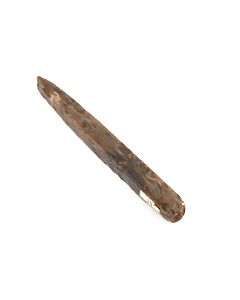 Neolithic chisel from Northern Germany
Neolithic chisel from Northern GermanyElegantly shaped chisel with two polished sides. Made of dark flint. Approx. 3400 to 2400 BC.
Price: on request Paleolithic hand axe of Homo Erectus
Paleolithic hand axe of Homo ErectusBig hand axe from Niger. Made during the Old Stone Age, around 200,000 years ago. The universal stone age tool could be use as a borer or cutting tool.
Price: on request Three neolithic arrowheads from Egypt
Three neolithic arrowheads from EgyptThe Stone Age points are beautifully crafted, with finely serrated edges. From a 100 year old museum collection.
Price: on request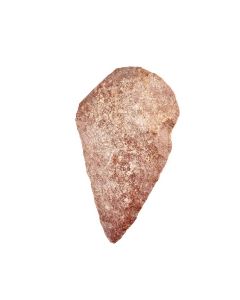 Paleolithic hand axe
Paleolithic hand axeThe universal tool of the older Stone age. It could be used as a borer or a cutter. Approx. 500,000 to 200,000 BC.
Price: on request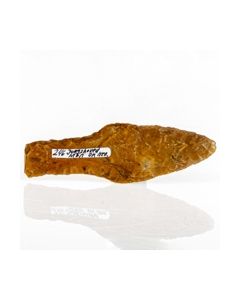 Scandinavian flint dagger
Scandinavian flint daggerNicely worked flint dagger from the transitional period between Late Neolithic and Early Bronze Age. Jungshoved on the Danish Island of Moen was the find spot.
Price: on request Two Mesopotamian mosaic cones
Two Mesopotamian mosaic conesThe pieces were part of a mosaic decoration of a Mesopotamian structure in the 4th Millenium BC. The temple architecture from Uruk is a particularly well known example of such a use.
Price: on request Old Babylonian cylinder seal
Old Babylonian cylinder sealThis Old Babylonian seal with a worship scene is made from lapis lazuli, a very rare choice for this period.
Price: on request Cone-shaped stamp seal with star of Ishtar
Cone-shaped stamp seal with star of IshtarThe seal depicts a tree of life with a rhomb and eight-pointed star, symbol of Ishtar. 7th to 6th century BC.
Price: on request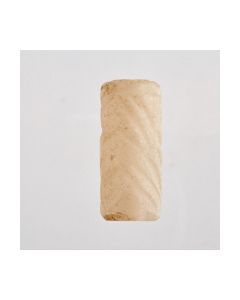 Mesopotamian cylinder seal with abstract scene
Mesopotamian cylinder seal with abstract sceneThe milky white stone is engraved with a scene that stands out by its high degree of abstraction. Late Uruk to Djemdet Nasr period, around 3000 BC.
Price: on request Early flat axe from Judea
Early flat axe from JudeaInteresting bronze axe head from Early Bronze Age. The piece was found in Judea.
Price: on request Early flat axe from Judea
Early flat axe from JudeaCompact bronze axe head from Early Bronze Age. The piece was found in Judea.
Price: on request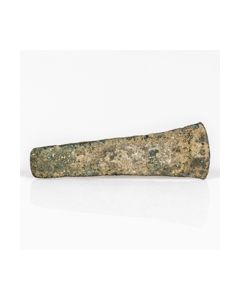 Early flat axe from Judea
Early flat axe from JudeaTrapezoidal axe head from Early Bronze Age. The piece was found in Judea.
Price: on request Flintwerkzeug aus Großbritannien
Flintwerkzeug aus GroßbritannienWerkzeug aus Flintstein, mit deutlichen, steinzeitlichen Bearbeitungsspuren. Britisches Neolithikum, möglicherweise früher.
Price: on request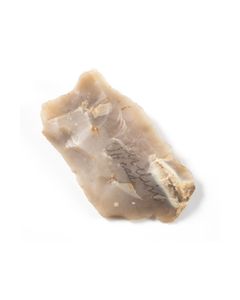 Flintwerkzeug aus Großbritannien
Flintwerkzeug aus GroßbritannienWerkzeug aus Flintstein, mit deutlichen, steinzeitlichen Bearbeitungsspuren. Britisches Neolithikum, möglicherweise früher.
Price: on request Flintwerkzeug aus Großbritannien
Flintwerkzeug aus GroßbritannienWerkzeug aus Flintstein, mit deutlichen, steinzeitlichen Bearbeitungsspuren. Britisches Neolithikum, möglicherweise früher.
Price: on request Neolithic dagger
Neolithic daggerNicely worked flint dagger of type III. Sprove on the Danish Island of Moen was the find spot. 1700 to 1500 BC.
Price: on request Beaker of the Bell Beaker culture
Beaker of the Bell Beaker cultureThe voluminous body has the typical shape of vessels from the Bell Beaker culture. It has been made during the transitioning period between Stone Age and Bronze Age.
Price: on request Hellenistic female head with melon coiffure
Hellenistic female head with melon coiffureAbout 5th century B.C. From an old collection of a Frech engineer.
Price: on request Achaemenid stamp seal
Achaemenid stamp sealThis beautiful stamp seal is from the First Persian Empire of the Achaemenids or from parts under Greek control. 5th to 4th cent. BC.
Price: on request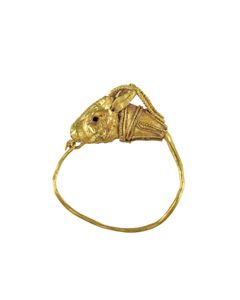 Hellenistic gold earring with antelope head
Hellenistic gold earring with antelope headEar pendant with plastically modeled head of an antelope. The elaborately made head is typical for hellenistic gold jewellery.
Price: on request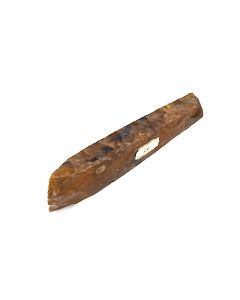 Neolithic axe head from Luetzow in Northern Germany
Neolithic axe head from Luetzow in Northern GermanyNice polished axe from brown flint. It was found more than 100 years ago near the town of Luetzow.
Price: on request Pair of early Byzantine gold earrings
Pair of early Byzantine gold earringsBeautiful jewellery with beads made of emerald and garnet. Made in the eastern part of the Mediterranean during the 6th to early 7th century.
Price: on request Vessel of the Linear Pottery culture
Vessel of the Linear Pottery cultureThe beautifully decorated tableware or cookware was made by the earliest peasants of Central Europe, the Late Stone Age Linear Band Ware settlers. A find from Southern Germany in great condition.
Price: on request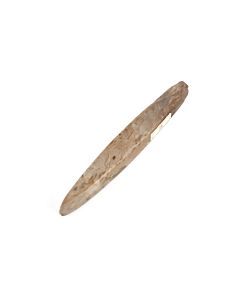 Neolithic chisel from Northern Germany
Neolithic chisel from Northern GermanyElegantly shaped chisel with two polished sides. Made of grey flint. Approx. 3400 to 2400 BC.
Price: on request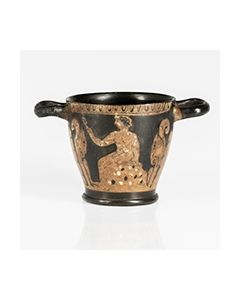 Very large Campanian red figure skyphos
Very large Campanian red figure skyphosDecorated with figures of youths, framed by palmettes. From an old German Frankonian collection. Acquired in the 1920s - 1930s.
Price: on request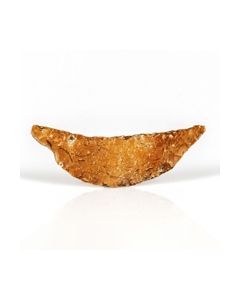 Small Neolithic sickle from Northern Germany
Small Neolithic sickle from Northern GermanyThe crescent-shaped blade is made of reddish brown flint. This tool represents an intermediate state within the radical transition from Neolithic to Bronze Age.
Price: on request

